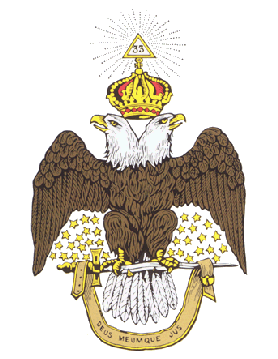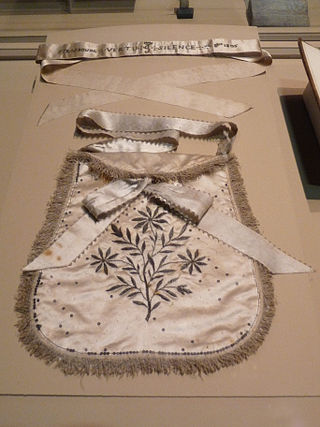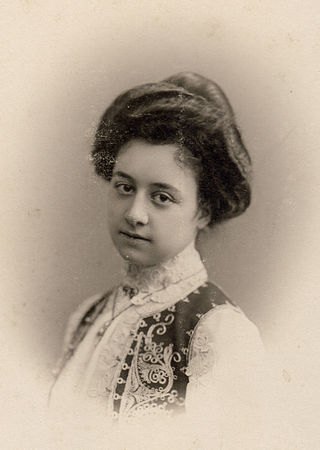Fraternal order that aims to promote individual moral growth and social harmony in Finland
Freemasonry in Finland began in the mid-18th century, during the period of Swedish rule in Finland.
| Part of a series on |
| Freemasonry |
|---|
 |
Freemasonry in Finland began in the mid-18th century, during the period of Swedish rule in Finland.

The first Swedish Order of Freemasons lodge in Finland was founded in 1756, in connection with the military fortification works at Sveaborg (Suomenlinna) and the officers stationed there. [1] The S:t Johannes logen S:t Augustin lodge worked partly in Stockholm, partly in Turku, but later moved to Helsinki. [1] Known Freemasons in Finland during the 18th century included Gustaf Björnram. [2] Anti-Masonic sentiments were already present among the Finnish Lutheran clergy and laity: the 1769 diocese meeting of Porvoo criticized the worldview of Freemasons and their activities. [1]
As the result of the Finnish War of 1808–1809, Sweden ceded its eastern provinces to Russia. These territories came to constitute the Grand Duchy of Finland under the Russian Empire. Lodge activities continued until 1813, but from 1822 onward, regulations banning secret societies in the Russian Empire made it impossible for Freemasons to operate in Finland. [1]
After the Finnish Declaration of Independence in 1917, Freemasonry was again free to operate in the country. In the early 1920s, the possibility of restoring Freemasonry to Finland was discussed among Finnish American Masons. [3] Unlike other European countries of the time, Finland adopted Freemasonry from the United States and not from England or Central Europe. The Suomi Lodge 1 opened in Helsinki in August 1922. [3] Finnish lodges initially operated under the Grand Lodge of New York. [3] The Independent Finnish Grand Lodge Association was founded in 1924. [3] In the European Masonic circles, the orientation of Finnish Freemasons to the United States caused bitterness: the United Grand Lodge of England did not recognize the Finnish Grand Lodge until 1927 while the Swedish Order of Freemasons withheld recognition until 1948. [4] [1]
The Grand Lodge was registered on 12 August 1935 under the name of the Grand Lodge of F. & A. Masons of Finland. [3] The name was changed to the Grand Lodge of Finland on 30 November 1983. [3]
In 1920, the Co-Masonic Le Droit Humain began its activities in Finland in connection with the Finnish Theosophical Society. [5]
In 1923, there was a revival of the Swedish Rite in Finland, when the Swedish Order of Freemasons reopened the S:t Augustin lodge and established operations in the Swedish-speaking parts of Finland. [1]
In the 1930s, Finnish far right groups, inspired by the Fascists and the Nazis, campaigned prominently against Freemasonry and similar organizations, such as the Odd Fellows. [1] There were also efforts to ban Masons from the officer corps of the Finnish Armed Forces and from the Lutheran clergy. [1] Due to the negative publicity, the number of Finnish Freemasons dropped from slightly under 1,000 to around 500 during the pre-war years. [1]
In 1941, Finnish lodges voluntarily ceased activities, to avoid complicating relations with Nazi Germany during the Continuation War against the Soviet Union. [1]
Masonic activities resumed in Finland after the Second World War, although not seriously until the early 1950s. [1] In the 1980s, inspired by the Italian P2 lodge scandal, the Finnish media published a number of stories about the alleged corruption of Finnish Freemasons active in politics and business. [1] Negative articles on Freemasonry were published in the large dailies in Helsinki, in the left-wing press, and in papers associated with certain religious groups. [1] The matter was also raised in the Finnish Parliament, but the government noted that Freemasonry was a lawful and accepted civic activity. [1]
In the decades since, Finnish Freemasonry has striven to decrease the secrecy surrounding it by, for example, opening a museum of Finnish Freemasonry and by cooperating with academic researchers. [1] The Finnish Grand Lodge system had 7,400 members in 2014 while the Swedish Rite system had 1,400 members in 2018. [3] [6] Le Droit Humain Finland had about 200 members in 2007. [5]

The Ancient and Accepted Scottish Rite of Freemasonry is a Rite within the broader context of Freemasonry. It is the most widely practiced Rite in the world. In some parts of the world, and in the Droit Humain, it is a concordant body and oversees all degrees from the 1st to 33rd degrees, while in other areas, a Supreme Council oversees the 4th to 33rd degrees.
Co-Freemasonry is a form of Freemasonry which admits both men and women. It began in France in the 1890s with the forming of Le Droit Humain, and is now an international movement represented by several Co-Freemasonic administrations throughout the world. Most male-only Masonic Lodges do not recognise Co-Freemasonry, holding it to be irregular.

The International Order of Freemasonry Le Droit Humain is a global Masonic Order, membership of which is available to men and women on equal terms, regardless of nationality, religion or ethnicity.

The Royal Order of Scotland is an appendant order within the structures of Freemasonry. Membership is an honour extended to Freemasons by invitation. The Grand Lodge of the Royal Order of Scotland is headquartered in Edinburgh, with a total of 88 subordinate Provincial Grand Lodges; of these, the greatest concentration is in the British Isles, with the rest located in countries around the world.
Freemasonry in Sweden was introduced by the Swedish Order of Freemasons, founded in 1735 as the oldest still active Swedish fraternal order, working the Swedish Rite of Freemasonry. It is under royal patronage of the King of Sweden and closely associated with the Lutheran Church of Sweden. It is a jurisdiction that admits Christian men only, and is recognised by the United Grand Lodge of England as a Regular Masonic jurisdiction, being the only Regular Grand Lodge that admits a 34th informal Masonic Degree. Its total membership is about 16,500.
This is a general survey on the historical and modern presence of Freemasonry in countries located in Asia.

Freemasonry has had a complex relationship with women for centuries. A few women were involved in Freemasonry before the 18th century, despite de jure prohibitions in the Premier Grand Lodge of England.
Freemasonry in Denmark was first established in 1743 and is today represented by a number of Grand Lodges. The oldest and biggest Masonic Grand Lodge in Denmark is the Danish Order of Freemasons, in English also known as the Grand Lodge of Denmark.
Continental Freemasonry, otherwise known as Liberal Freemasonry, Latin Freemasonry, and Adogmatic Freemasonry, includes the Masonic lodges, primarily on the European continent, that recognize the Grand Orient de France (GOdF) or belong to CLIPSAS, SIMPA, TRACIA **, CIMAS, COMAM, CATENA, GLUA, or any of various other international organizations of Liberal, i.e., Continental Freemasonry. The larger number of Freemasons, most of whom live in the United States–where Regular Freemasonry holds a virtual monopoly–belong to Masonic lodges that recognize the United Grand Lodge of England and do not recognize Continental Freemasons, regarding them as "irregular".
Freemasonry in France has been influential on the worldwide Masonic movement due to its founding of Continental Freemasonry.
Continental Freemasonry in North America is relatively rare, but there are a few continental-style organizations active.
The history of Freemasonry in Belgium reflects the many influences on what is now Belgium from the neighbouring states.
The Women's Grand Lodge Of France is the Grand Lodge of France's women-only Masonic lodges.
The first known Freemasons in Portugal were the Swiss John Coustos and two other Portuguese members of his lodge, who were arrested by the Portuguese Inquisition and questioned under torture in the 1740s. Coustos wrote a book detailing his sufferings under the Inquisition and pointed to 1728 as being the year of the first Lodge, although nothing is known of the first years of this Lodge and it was not then recognised by the Grand Lodge of England. Today there are several Masonic Obediences in Portugal.
Freemasonry in Spain is first recorded in 1728, in an English lodge. As various papal bulls condemned Freemasonry the Spanish Inquisition did their best to close lodges and demonise Freemasons, therefore the success of Freemasonry from year to year depended on the sympathy or antipathy of the ruling regime. Nevertheless, lodges and even Grand Lodges were formed, and even thrived during more liberal periods. When Francisco Franco consolidated power in 1939, all Freemasonry was banned. In 1979, four years after Franco's death, bans on Freemasonry were declared unconstitutional, and several Grand Lodges and Orients now flourish in Spain.

Amina Hanum Syrtlanoff or Syrtlanova — public figure, sister of mercy, theosophist, mason.
Freemasonry in Germany started in several places during the second quarter of the Eighteenth century. After the extinction of the Rite of Strict Observance, which had a wide following and claimed Templar origins for its higher degrees, the several Grand Lodges in Germany defied all attempts at unification, although a largely ineffectual central organisation came into being with the unification of Germany. During the 1920s Freemasons were harassed alongside Jews by those taken in by the Protocols of the Elders of Zion, and blamed for the German surrender of 1918. This culminated with the suppression of Freemasonry by the Nazis in 1935, with many Masons in Germany and occupied countries being executed or sent to concentration camps. Freemasonry returned to Germany after World War Two. A single central body now represents five "regular" Grand Lodges. Liberal, women's, and mixed lodges also exist.
Freemasonry in Italy dates to the first half of the eighteenth century. Its success largely depended on the lack of enthusiasm with which Papal bans on the order were enforced in the various states, but after the end of the Napoleonic regime, Freemasonry was suppressed in most of the peninsula. The start of the unification process in 1859 saw a revival in Freemasonry. Giuseppe Garibaldi, a leader of Italian unification, was an active Mason and a keen supporter of the craft. In the 1920s Freemasonry was again suppressed under Fascism but revived again after the fall of Benito Mussolini. Today's Italy contains a wide variety of Masonic observances, regular, liberal, male, female and mixed.
Freemasonry in Croatia may be traced to the second half of the 18th century when it was introduced by the officers that came back from the Seven Years' War (1756–1763). However, the fraternity has been repeatedly banned and re-founded since then.

Universal Co-Masonry, is an international fraternal Masonic organization headquartered in Larkspur, Colorado. Formally a national Federation of Le Droit Humain, the international order of mixed co-freemasonry, Universal Co-Masonry split off in 1994 to become an independent masonic obedience. The organization seeks to “combat ignorance in all its forms” and works “to the Glory of God and the Perfection of Humanity”. Universal Co-Masonry has created “a Masonic Government that ensures the maximum liberty compatible with a voluntarily accepted discipline and is organized upon the precepts of the Ancient Mystery Schools, the Scottish Rite, and the English Rite”. Universal Co-Masonry is active in North America, South America, and the Philippines. Universal Co-Masonry also oversees the administration of the Masonic Philosophical Society, a philosophical discussion and educational society that meets online and in several countries.